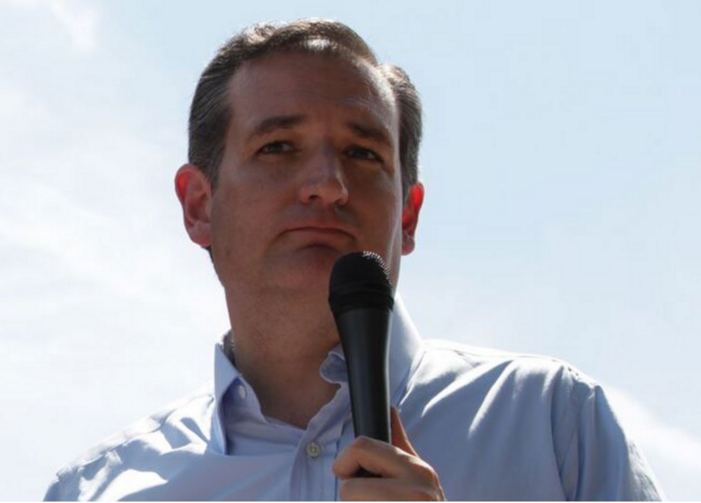Donald Trump is giving headaches to the Republican Party establishment in all kinds of ways, but one underappreciated threat is to the relatively moderate coalition that installed John McCain and Mitt Romney as GOP nominees in 2008 and 2012. Even if Trump fails to win a single primary, he could tip primaries in states like Illinois and Ohio to tea party favorite Ted Cruz by getting just 10 to 15 percent of the vote in more densely populated areas. No so-called establishment candidate (Rubio, Bush, Christie, Kasich) can get the nomination without getting big majorities in counties that vote Democratic in November.
The more densely populated a county is, the more likely it is to vote Democratic. This is true to a startlingly precise degree: as statistician Dave Troy discovered, “At about 800 people per square mile, people switch from voting primarily Republican to voting primarily Democratic.” So more urban states vote Democratic, and more rural states vote Republican.
It is also true that Republican presidential candidates with some appeal to the middle, as opposed to hard-right candidates like Mike Huckabee in 2008 and Rick Santorum in 2012, do better in more urban areas—and probably could not win a GOP nomination without them. In presidential primary seasons, insurgent candidates from the right won almost every red-state contest (not counting the ones held after almost everyone had dropped out of the race), sweeping the South and the rural interior, while McCain and Romney dominated primaries in states that would vote for Barack Obama in the general election, including New Hampshire. The blue-state strategy proved to be effective against Huckabee and Santorum, neither of whom could expand much beyond their rural, evangelical base.
The danger for whoever emerges as the establishment candidate in 2016 is Trump’s appeal among dense-suburb and city voters who are not especially religious. Rubio (or Bush, Christie or Kasich) would need almost all these voters if Ted Cruz consolidates the more rural, more evangelical wing of the party. But Trump’s appeal is based on real differences with the establishment candidates—he takes a harder line against legal and illegal immigration, he opposes changes to Social Security such as raising the retirement age, and he disparages the interventionist, “nation-building” foreign policy championed by the last Republican president, George W. Bush.
With these differences, could any candidate grab all of Trump’s voters to assemble a kind of anybody-but-Cruz coalition? Rubio is in the best position to survive a race with both Trump or Cruz, but his increasingly hard-line rhetoric on Planned Parenthood and gay marriage may limit his appeal among more socially moderate Republicans. At the same time, his past support for immigration reform makes him vulnerable among the white, non-college-educated voters now allied with Trump. The New Republic’s Brian Beutler puts it bluntly: “To the extent that anyone in the Republican primary today holds a mirror up to the GOP base—old, cantankerous, nativist, and caucasian—it’s Donald Trump. Which is to say, it’s definitely not Marco Rubio.”
Is Rubio a bad fit for GOP primary voters even in Chicago and in suburban Detroit? He may need big wins in those places to beat Cruz. That may be impossible with Trump still in the race.
The GOP establishment’s urban dependency
Here are some examples of how dependent the establishment wing of the party is on the urban vote. With a more divided urban vote, Ted Cruz—perhaps a better campaigner than the too-folksy Huckabee and dour Santorum—could win in some surprising states.
In 2008, Huckabee won 24 of South Carolina’s 46 counties, but McCain won the state by 3 points and became the undisputed front-runner for the nomination. He would not have won without double-digit margins in relatively urban Charleston, Richland (Columbia), and Beaufort (Hilton Head) counties. Charleston and Richland counties voted for Obama in 2008 and 2012.
In America’s most crowded county, New York (i.e., Manhattan), John McCain won 59 percent in the 2008 GOP primary to 21 percent for Romney, then running to McCain’s right, and 8 percent for Huckabee. In San Francisco, McCain got 54 percent to Romney’s 22 percent and Huckabee’s 6 percent. Such lopsided margins helped McCain to win California, New York, and most of the “Super Tuesday” primaries, driving Romney from the race and giving McCain an insurmountable delegate lead over Huckabee.
Huckabee dominated the western half of Virginia, but McCain won that state’s primary by nine points. McCain would not have won without double-digit margins in the suburbs of Washington, D.C. (the city of Alexandria and Arlington, Fairfax, Loudon, and Prince William Counties) and in the city of Richmond and adjoining Henrico County. All of these places voted for Obama in 2008 and 2012. Huckabee’s loss in a Southern state essentially spelled the end of his campaign.
In 2012, Santorum won 53 of 83 counties in the Michigan primary, but Romney got a 3-point win thanks to margins in Detroit’s Wayne County and next-door Oakland County (which both went for Obama in 2008 and 2012). Santorum’s loss here stopped his momentum from wins in Colorado, Minnesota, and Missouri.
In Ohio, Santorum won 69 of the state’s 88 counties, thrashing Romney in small towns along the Indiana and West Virginia borders. But Romney’s win in heavily Democratic Cuyahoga County (Cleveland) was enough to give him a 1.01-point margin statewide.
Even in Illinois, historically a base for the Republican Party’s moderate wing, Santorum took 74 of 102 counties, winning just about everywhere along the Mississippi River and in the southern half of the state. But Romney’s double-digit wins in Chicago’s Cook County and in three nearby “collar counties” (DuPage, Lake, and Will) gave him a 12-point victory statewide. All of these counties voted for Obama in 2008 and 2012. With losses in three big Midwestern states, Santorum’s chances to make it to the convention ended.








